Haidao Suanjing
Haidao Suanjing (海島算經; The Sea Island Mathematical Manual) was written by the Chinese mathematician Liu Hui of the Three Kingdoms era (220–280) as an extension of chapter 9 of The Nine Chapters on the Mathematical Art.[1] During the Tang Dynasty, this appendix was taken out from The Nine Chapters on the Mathematical Art as a separate book, titled Haidao suanjing (Sea Island Mathematical Manual), named after problem No 1 "Looking at a sea island." In the time of the early Tang dynasty, Haidao Suanjing was selected into one of The Ten Computational Canons as the official mathematical texts for imperial examinations in mathematics.
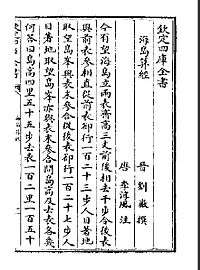
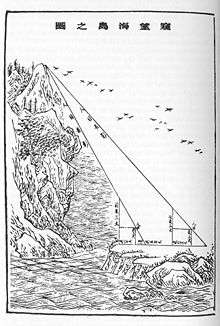
Content

This book contained many practical problems of surveying using geometry. This work provided detailed instructions on how to measure distances and heights with tall surveyor's poles and horizontal bars fixed at right angles to them. The unit of measurement was 1 li = 180 zhang= 1800chi, 1 zhang = 10 chi, 1 chi = 10 cun, 1 step(bu) = 6 chi. Calculation was carried out with place value decimal Rod calculus.
Liu Hui used his rectangle in right angle triangle theorem as the mathematical basis for survey. With his "In-out-complement" principle, he proved that the area of two inscribed rectangles in the two complementary right angle triangles have equal area, thus
CE * AF = FB * BC
Survey of sea island
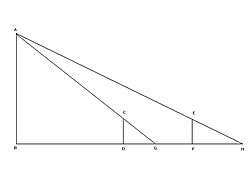
Q: Now surveying a sea island, set up two three zhang poles at one thousand steps apart, let the two poles and the island in a straight line. Step back from the front post 123 steps, with eye on ground level, the tip of the pole is on a straight line with the peak of island. Step back 127 steps from the rear pole, eye on ground level also aligns with the tip of pole and tip of island. What is the height of the island, and what is the distance to the pole ?
A: The height of the island is four li and 55 steps, and it is 120 li and 50 steps from the pole.
Algorithm: Let the numerator equals to the height of pole multiplied by the separation of poles, let denominator be the difference of offsets, add the quotient to the height of pole to obtain the height of island.
As the distance of front pole to the island could not be measured directly, Liu Hui set up two poles of same height at a known distance apart and made two measurements. The pole was perpendicular to the ground, eye view from ground level when the tip of pole was on a straight line sight with the peak of island, the distance of eye to the pole was called front offset =DG, similarly, the back offset =FH, difference of offsets =FH-DG.
- Pole height =CD= 30 chi
- Front pole offset=DG=123 steps
- Back pole offset FH=127 steps
- Difference of offset=FH-DG
- Distance between the poles =DF
- Height of island =AB
- Disttance of front pole to island=BD
Using his principle of inscribe rectangle in right angle triangle for ABG and ABH, he obtained:
- Height of island AB=
- Distance of front pole to island BD=.
Height of a hill top pine tree
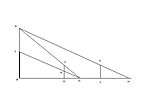
A pine of unknown height on a hill. Set up two poles of two zhang each, one at front and one at the rear 50 steps in between. Let the rear pole aligns with the front pole. Step back 7 steps and 4 chi, view the tip of pine tree from the ground till it aligns in a straight line with the tip of the pole. Then view the tree trunk, the line of sight intersects the poles at 2 chi and 8 cun from its tip . Step back 8 steps and 5 chi from the rear pole, the view from ground also aligns with tree top and pole top. What is the height of the pine tree, and what is its distance from the pole ? Answer: the height of the pine is 11 zhang 2 chi 8 cun, the distance of mountain from the pole is 1 li and 28 and four seventh steps.
Algorithm: let the numerator be the product of separation of the poles and intersection from tip of pole, let the denominator be the difference of offsets. Add the height of pole to the quotient to obtain the height of pine tree.
The size of a square city wall viewed afar
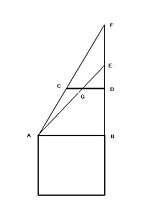
Q:View a square city at the south of unknown size. Set up an east gnome and a west pole, six zhang apart, linked with a rope at eye level. Let the east pole aligned with the NE and SE corners. Step back 5 steps from the north gnome, watch the NW corner of the city, the line of sight intersects the rope at 2 zhang 2 chi and 6.5 cun from the east end. Step back northward 13 steps and 2 chi, watch the NW corner of the city, the line of sight just aligns with the west pole. What is the length of the square city, and what is its distance to the pole ?
A: The length of the square city is three li 43 and three quarter steps, the distance of the city to the pole is four li and 45 steps.
The depth of a ravine (using hence-forward cross-bars)
The height of a building on a plain seen from a hill
The breadth of a river-mouth seen from a distance on land
The depth of a transparent pool

The width of a river as seen from a hill
The size of a city seen from a mountain
Studies and translations
The 19th century British Protestant Christian missionary Alexander Wylie in his article "Jottings on the Sciences of Chinese Mathematics" published in North China Herald 1852, was the first person to introduce Sea Island Mathematical Manual to the West. In 1912, Japanese mathematic historian Yoshio Mikami published The Development of Mathematics in China and Japan, chapter 5 was dedicated to this book.[2] A French mathematician translated the book into French in 1932.[1] In 1986 Ang Tian Se and Frank Swetz translated Haidao into English.
After comparing the development of surveying in China and the West, Frank Swetz concluded that "in the endeavours of mathematical surveying, China's accomplishments exceeded those realized in the West by about one thousand years."[3]
References
| Wikisource has original text related to this article: |
- L. van. Hee, Le Classique d I'Ile Maritime: Ouvrage Chinois de III siecle 1932
- Yoshio Mikami, The Development of Mathematics in China and Japan, chapter 5, The Hai Tao Suan-ching or Sea Island Arithmetical Classic, 1913 Leipzig, reprint Chelsea Publishing Co, NY
- Frank J. Swetz: The Sea Island Mathematical Manual, Surveying and Mathematics in Ancient China 4.2 Chinese Surveying Accomplishments, A Comparative Retrospection p.63 The Pennsylvania State University Press, 1992 ISBN 0-271-00799-0